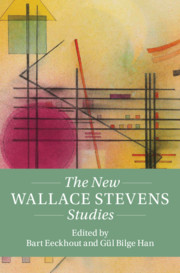Book contents
- The New Wallace Stevens Studies
- Twenty-First-Century Critical Revisions
- The New Wallace Stevens Studies
- Copyright page
- Contents
- Contributors
- Abbreviations
- Introduction That Which Is Always Beginning
- Part I Emerging Concepts in Stevens Criticism
- Part II Recent Critical Methods Applied to Stevens
- Part III Revisionary Readings of Stevens
- Chapter 12 Poetic Responses
- Chapter 13 Poetic Fiction
- Chapter 14 Poetic Thinking
- Chapter 15 Constructive Disorderings
- Chapter 16 Manner and Manners
- Chapter 17 Lyrical Ethics
- Index
- References
Chapter 12 - Poetic Responses
from Part III - Revisionary Readings of Stevens
Published online by Cambridge University Press: 18 June 2021
- The New Wallace Stevens Studies
- Twenty-First-Century Critical Revisions
- The New Wallace Stevens Studies
- Copyright page
- Contents
- Contributors
- Abbreviations
- Introduction That Which Is Always Beginning
- Part I Emerging Concepts in Stevens Criticism
- Part II Recent Critical Methods Applied to Stevens
- Part III Revisionary Readings of Stevens
- Chapter 12 Poetic Responses
- Chapter 13 Poetic Fiction
- Chapter 14 Poetic Thinking
- Chapter 15 Constructive Disorderings
- Chapter 16 Manner and Manners
- Chapter 17 Lyrical Ethics
- Index
- References
Summary
Epstein’s chapter challenges the tendency to overlook the significance of Wallace Stevens—and his characteristic idiom, poetics, and philosophical concerns—to the postwar avant-garde movement known as the New York School of poets. This neglect of Stevens as an important precursor causes problems in both directions: it unnecessarily limits our sense of New York School poetry, which can too easily be reduced to a chatty, pop-culture-infused poetry of urban daily life, while simultaneously reinforcing the distorted image of Stevens as a stuffy, backward-looking aesthete, devoted solely to abstraction and imagination. Epstein suggests that, for all their differences, Stevens and the New York School poets share a great deal: an obsession with painting and a passion for all things French; a delight in wordplay and the sensuous surfaces of language; an anti-foundational skepticism toward fixity in self, language, or idea; and, perhaps most of all, an embrace of the imagination and deep attraction to the surreal combined with a devotion to the ordinary and everyday.
Keywords
- Type
- Chapter
- Information
- The New Wallace Stevens Studies , pp. 161 - 173Publisher: Cambridge University PressPrint publication year: 2021

